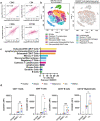23ME-00610, a genetically informed, first-in-class antibody targeting CD200R1 to enhance antitumor T cell function
- PMID: 37288324
- PMCID: PMC10243377
- DOI: 10.1080/2162402X.2023.2217737
23ME-00610, a genetically informed, first-in-class antibody targeting CD200R1 to enhance antitumor T cell function
Abstract
Immune checkpoint inhibition (ICI) has revolutionized cancer treatment; however, only a subset of patients benefit long term. Therefore, methods for identification of novel checkpoint targets and development of therapeutic interventions against them remain a critical challenge. Analysis of human genetics has the potential to inform more successful drug target discovery. We used genome-wide association studies of the 23andMe genetic and health survey database to identify an immuno-oncology signature in which genetic variants are associated with opposing effects on risk for cancer and immune diseases. This signature identified multiple pathway genes mapping to the immune checkpoint comprising CD200, its receptor CD200R1, and the downstream adapter protein DOK2. We confirmed that CD200R1 is elevated on tumor-infiltrating immune cells isolated from cancer patients compared to the matching peripheral blood mononuclear cells. We developed a humanized, effectorless IgG1 antibody (23ME-00610) that bound human CD200R1 with high affinity (KD <0.1 nM), blocked CD200 binding, and inhibited recruitment of DOK2. 23ME-00610 induced T-cell cytokine production and enhanced T cell-mediated tumor cell killing in vitro. Blockade of the CD200:CD200R1 immune checkpoint inhibited tumor growth and engaged immune activation pathways in an S91 tumor cell model of melanoma in mice.
Keywords: 23ME-00610; CD200; CD200R1; cancer immunotherapy; immune checkpoint.
© 2023 23andMe. Published with license by Taylor & Francis Group, LLC.
Conflict of interest statement
XF, YH, CM, ELL, TP, AZ, MP, SRM, DG, MS, CCL: Employees of 23andMe JF, CB, CL, ZY, WC, AC: Employees of 23andMe at the time this work was performed
Figures








References
-
- Wright GJ, Cherwinski H, Foster-Cuevas M, Brooke G, Puklavec MJ, Bigler M, Song Y, Jenmalm M, Gorman D, McClanahan T, et al. Characterization of the CD200 receptor family in mice and humans and their interactions with CD200. J Immunol. 2003;171(6):3034–3046. doi: 10.4049/jimmunol.171.6.3034. - DOI - PubMed
Publication types
MeSH terms
Substances
LinkOut - more resources
Full Text Sources
Other Literature Sources
